
- •Foreword
- •Preface
- •Is This Book for You?
- •How This Book Is Organized
- •How to Use This Book
- •Doing the Exercises
- •Conventions Used in This Book
- •What the Icons Mean
- •About the CD-ROM
- •Other Information
- •Contacting the Author
- •Acknowledgments
- •Contents at a Glance
- •Contents
- •Getting Acquainted with AutoCAD and AutoCAD LT
- •Starting AutoCAD and AutoCAD LT
- •Creating a New Drawing
- •Using the AutoCAD and AutoCAD LT Interface
- •Creating Your First Drawing
- •Saving a Drawing
- •Summary
- •Creating a New Drawing from a Template
- •Working with Templates
- •Opening a Drawing with Default Settings
- •Opening an Existing Drawing
- •Using an Existing Drawing as a Prototype
- •Saving a Drawing Under a New Name
- •Summary
- •The Command Line
- •Command Techniques
- •Of Mice and Pucks
- •Getting Help
- •Summary
- •Typing Coordinates
- •Displaying Coordinates
- •Picking Coordinates on the Screen
- •Locating Points
- •Summary
- •Unit Types
- •Drawing Limits
- •Understanding Scales
- •Inserting a Title Block
- •Common Setup Options
- •The MVSETUP Command
- •Summary
- •Using the LINE Command
- •Drawing Rectangles
- •Drawing Polygons
- •Creating Construction Lines
- •Creating Rays
- •Summary
- •Drawing Circles
- •Drawing Arcs
- •Creating Ellipses and Elliptical Arcs
- •Making Donuts
- •Placing Points
- •Summary
- •Panning
- •The ZOOM Command
- •Aerial View
- •Named Views
- •Tiled Viewports
- •Snap Rotation
- •User Coordinate Systems
- •Isometric Drawing
- •Summary
- •Editing a Drawing
- •Selecting Objects
- •Summary
- •Copying and Moving Objects
- •Using Construction Commands
- •Creating a Revision Cloud
- •Hiding Objects with a Wipeout
- •Double-Clicking to Edit Objects
- •Grips
- •Editing with the Properties Palette
- •Selection Filters
- •Groups
- •Summary
- •Working with Layers
- •Changing Object Color, Linetype, and Lineweight
- •Working with Linetype Scales
- •Importing Layers and Linetypes from Other Drawings
- •Matching Properties
- •Summary
- •Drawing-Level Information
- •Object-Level Information
- •Measurement Commands
- •AutoCAD’s Calculator
- •Summary
- •Creating Single-Line Text
- •Understanding Text Styles
- •Creating Multiline Text
- •Creating Tables
- •Inserting Fields
- •Managing Text
- •Finding Text in Your Drawing
- •Checking Your Spelling
- •Summary
- •Working with Dimensions
- •Drawing Linear Dimensions
- •Drawing Aligned Dimensions
- •Creating Baseline and Continued Dimensions
- •Dimensioning Arcs and Circles
- •Dimensioning Angles
- •Creating Ordinate Dimensions
- •Drawing Leaders
- •Using Quick Dimension
- •Editing Dimensions
- •Summary
- •Understanding Dimension Styles
- •Defining a New Dimension Style
- •Changing Dimension Styles
- •Creating Geometric Tolerances
- •Summary
- •Creating and Editing Polylines
- •Drawing and Editing Splines
- •Creating Regions
- •Creating Boundaries
- •Creating Hatches
- •Creating and Editing Multilines
- •Creating Dlines
- •Using the SKETCH Command
- •Digitizing Drawings with the TABLET Command
- •Summary
- •Preparing a Drawing for Plotting or Printing
- •Creating a Layout in Paper Space
- •Working with Plot Styles
- •Plotting a Drawing
- •Summary
- •Combining Objects into Blocks
- •Inserting Blocks and Files into Drawings
- •Managing Blocks
- •Using Windows Features
- •Working with Attributes
- •Summary
- •Understanding External References
- •Editing an Xref within Your Drawing
- •Controlling Xref Display
- •Managing Xrefs
- •Summary
- •Preparing for Database Connectivity
- •Connecting to Your Database
- •Linking Data to Drawing Objects
- •Creating Labels
- •Querying with the Query Editor
- •Working with Query Files
- •Summary
- •Working with 3D Coordinates
- •Using Elevation and Thickness
- •Working with the User Coordinate System
- •Summary
- •Working with the Standard Viewpoints
- •Using DDVPOINT
- •Working with the Tripod and Compass
- •Getting a Quick Plan View
- •Shading Your Drawing
- •Using 3D Orbit
- •Using Tiled Viewports
- •Defining a Perspective View
- •Laying Out 3D Drawings
- •Summary
- •Drawing Surfaces with 3DFACE
- •Drawing Surfaces with PFACE
- •Creating Polygon Meshes with 3DMESH
- •Drawing Standard 3D Shapes
- •Drawing a Revolved Surface
- •Drawing an Extruded Surface
- •Drawing Ruled Surfaces
- •Drawing Edge Surfaces
- •Summary
- •Drawing Standard Shapes
- •Creating Extruded Solids
- •Drawing Revolved Solids
- •Creating Complex Solids
- •Sectioning and Slicing Solids
- •Using Editing Commands in 3D
- •Editing Solids
- •Listing Solid Properties
- •Summary
- •Understanding Rendering
- •Creating Lights
- •Creating Scenes
- •Working with Materials
- •Using Backgrounds
- •Doing the Final Render
- •Summary
- •Accessing Drawing Components with the DesignCenter
- •Accessing Drawing Content with Tool Palettes
- •Setting Standards for Drawings
- •Organizing Your Drawings
- •Working with Sheet Sets
- •Maintaining Security
- •Keeping Track of Referenced Files
- •Handling Errors and Crashes
- •Managing Drawings from Prior Releases
- •Summary
- •Importing and Exporting Other File Formats
- •Working with Raster Images
- •Pasting, Linking, and Embedding Objects
- •Summary
- •Sending Drawings
- •Opening Drawings from the Web
- •Creating Object Hyperlinks
- •Publishing Drawings
- •Summary
- •Working with Customizable Files
- •Creating Keyboard Shortcuts for Commands
- •Customizing Toolbars
- •Customizing Tool Palettes
- •Summary
- •Creating Macros with Script Files
- •Creating Slide Shows
- •Creating Slide Libraries
- •Summary
- •Creating Linetypes
- •Creating Hatch Patterns
- •Summary
- •Creating Shapes
- •Creating Fonts
- •Summary
- •Working with Menu Files
- •Customizing a Menu
- •Summary
- •Introducing Visual LISP
- •Getting Help in Visual LISP
- •Working with AutoLISP Expressions
- •Using AutoLISP on the Command Line
- •Creating AutoLISP Files
- •Summary
- •Creating Variables
- •Working with AutoCAD Commands
- •Working with Lists
- •Setting Conditions
- •Managing Drawing Objects
- •Getting Input from the User
- •Putting on the Finishing Touches
- •Summary
- •Understanding Local and Global Variables
- •Working with Visual LISP ActiveX Functions
- •Debugging Code
- •Summary
- •Starting to Work with VBA
- •Writing VBA Code
- •Getting User Input
- •Creating Dialog Boxes
- •Modifying Objects
- •Debugging and Trapping Errors
- •Moving to Advanced Programming
- •A Final Word
- •Installing AutoCAD and AutoCAD LT
- •Configuring AutoCAD
- •Starting AutoCAD Your Way
- •Configuring a Plotter
- •System Requirements
- •Using the CD with Microsoft Windows
- •What’s on the CD
- •Troubleshooting
- •Index

Chapter 8 Viewing Your Drawing 143
3.Choose View Viewports New Viewports to open the Viewports dialog box.
4.In the listing at the left of the dialog box, choose Three: Above. Click OK. You see three tiled viewports.
5.Click the bottom-right viewport. Choose Zoom Window on the Zoom flyout of the Standard toolbar and choose a window around the left portion of the threaded model (the upper part of the drawing).
6.Click the bottom-left viewport. Choose Zoom Window on the Zoom flyout of the Standard toolbar and choose a window around the bottom-left portion of the drawing (not including the title block).
7.Click the top viewport. Choose Zoom Extents from the Zoom flyout of the Standard toolbar. Figure 8-16 shows the results.
Figure 8-16: The three tiled viewports now display three different views.
8.Choose View Viewports New Viewports. In the New Name text box, type 3 view O Ring and click OK.
9.With the top viewport still active, choose View Viewports 1 Viewport to display the view shown in the last active viewport.
10.Choose View Viewports Named Viewports.
11.Choose 3 view O Ring and click OK to restore the viewport configuration, including the views in each viewport.
12.Save your drawing.
Snap Rotation
Not all 2D drawings are vertical and horizontal. In some drawings, a significant portion of your objects are drawn at nonorthogonal angles. One example is an auxiliary view to show the “true size” of an inclined surface. Sometimes it helps to rotate the crosshairs to match the major angles of the drawing.

144 Part II Drawing in Two Dimensions
Consider Figure 8-17. A great deal of this drawing is at an angle. You could handle this in four ways:
Draw as normal, specifying the necessary angles.
Rotate the snap, which also rotates the grid and crosshairs.
Create a new UCS (User Coordinate System).
Draw the entire model vertically and rotate it afterward.
Figure 8-17: In 2D drawings such as this, you should consider various options, such as rotating the snap or creating a new UCS.
Thanks to Robert Mack of The Dexter Company, Fairfield, Iowa, for this drawing.
Creating a new UCS is covered later in this chapter.
If you need to draw several objects at a certain angle, such as 45 degrees, you can rotate the snap to that angle. The grid and crosshairs rotate to follow suit. This technique works best when the decimal point accuracy required lets you draw using snap points. You can also use this technique to guide the cursor at an appropriate angle for direct distance entry, although polar tracking is another way to accomplish the same task.
To change the snap rotation angle, choose Tools Drafting Settings (or right-click SNAP on the status bar and choose Settings) to open the Drafting Settings dialog box. In the Snap section, type an angle in the Angle text box.
Note that you can also set an X base and a Y base. This simply ensures that the grid goes through a point of your choice, which is very important if you’re using Snap mode to draw. If you’re just starting to draw an object, use the 0,0 base and draw to the existing snap points. However, if you have an existing object and need to add to it, changing the base can be very helpful. Setting X and Y bases does not change the coordinates, which are tied to the UCS. (The UCS is discussed in the next section.)
Cross- |
You can use the ID command to get the coordinates of a point. Then use these coordinates |
Reference |
as the X and Y bases. Chapter 12 covers the ID command. |
|
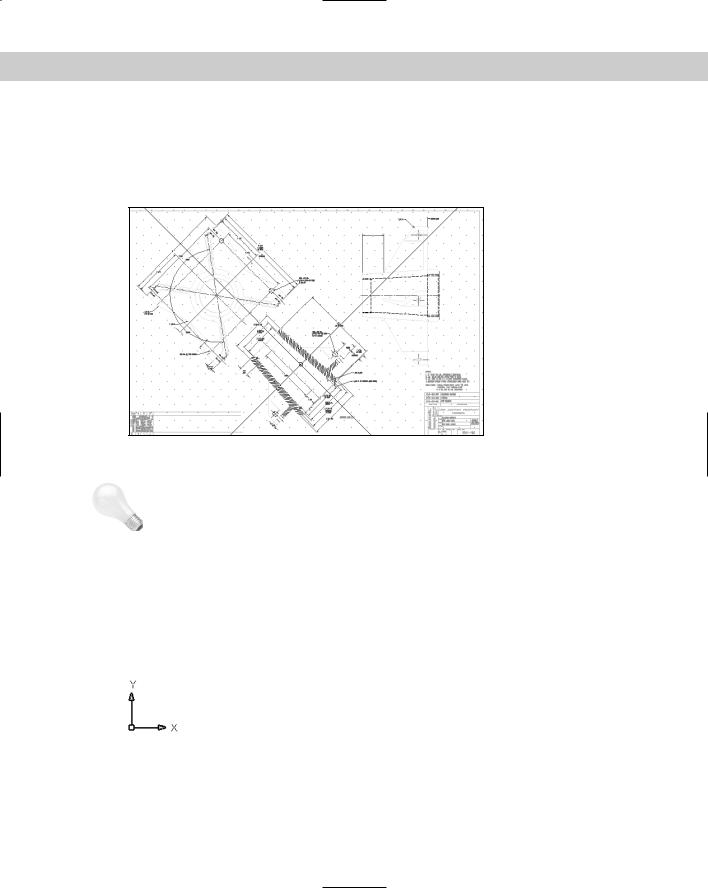
Chapter 8 Viewing Your Drawing 145
Click OK to return to your drawing. Make sure that the grid is on. The crosshairs and grid now reflect the new snap angle. Figure 8-18 shows the same drawing with a snap angle of 45 degrees. Notice how the crosshairs now match the angle of the drawing. The crosshairs have been set to 100 percent of screen size, which is useful when rotating the snap angle. (To reset the crosshairs size, choose Tools Options and click the Display tab.)
|
Figure 8-18: The snap angle in this drawing has been changed to |
|
45 degrees. Note that the grid follows the snap. |
Tip |
The grid does not have to be on, but it helps you get your bearings when working with an |
|
unusual snap angle. |
|
You can create a new UCS (User Coordinate System) rather than rotate the snap angle. The |
|
results are similar, except that when you create a UCS, you also affect the X,Y coordinates. |
|
The UCS is much more flexible when you start drawing in three dimensions. |
User Coordinate Systems
By default, a drawing is set up by using a World Coordinate System. This sets the origin of the X,Y points at 0,0 and the angles using the familiar East (right-facing) equals 0 degrees system. Figure 8-19 shows the UCS icon in its default display.
Figure 8-19: The UCS icon in its default display.
You can easily create your own UCS and even save it for future use in the drawing. Creating a UCS is essential for 3D drawing but often useful for 2D drawing as well.
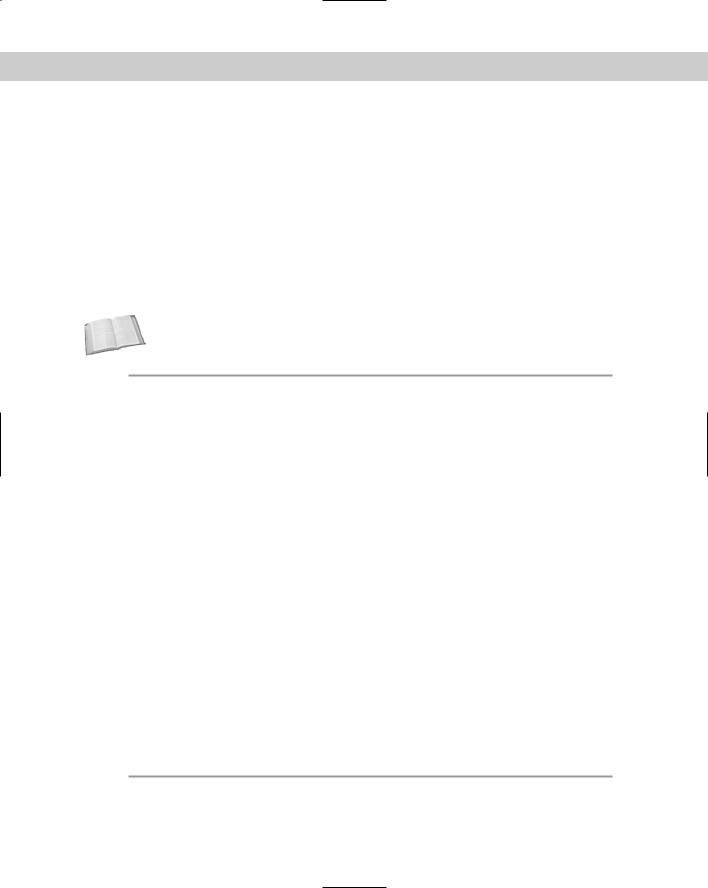
146 Part II Drawing in Two Dimensions
To define a UCS in a 2D drawing, you indicate the angle of the X and Y axes and an origin point. The origin point then becomes the new 0,0 coordinate. You have several options for specifying the UCS.
Understanding UCS options
Understanding the UCS options will help you create a new UCS more easily, based on the information you have available. To create a UCS, choose Tools New UCS. A submenu opens offering the options listed in Table 8-2.
Choose Tools Move UCS to leave the orientation of the X and Y axes the same but move the origin. This option is similar to the Origin option. You can specify a new origin or, for a 3D drawing, move the origin along the Z axis by a positive or negative number of units (called the Z depth).
Cross- |
Choose Tools Orthographic UCS to open a submenu with several preset views. These views |
Reference |
are used only in 3D drawings. See Chapter 21 for details on 3D coordinates. |
|
|
Table 8-2: UCS Options |
|
|
Option |
Meaning |
|
|
World |
Specifies the default UCS, with the X axis horizontal, the Y axis vertical, and the origin at |
|
the initial 0,0 location. |
Object |
Enables you to align the UCS with an object. In general, this option uses the most |
|
obvious object snap as the origin and aligns the X axis with the object. For example, |
|
when you choose a line, the endpoint nearest your pick point becomes the origin and |
|
the X axis aligns with the angle of the line. When you choose a circle, the X axis points |
|
toward the point you pick on the circumference. |
Face |
Aligns the UCS with the face of a 3D solid. |
View |
Aligns the X and Y axes with the current view. Used in 3D drawing. This option arbitrarily |
|
sets the origin. |
Origin |
Specifies a new 0,0 point of your choice relative to the current origin. |
Z Axis Vector |
Specifies which way the Z axis points. This option is not used in 2D drawing. |
3 Point |
Enables you to specify three points. The first point is the origin, the second point indicates |
|
the positive direction of the X axis, and the third point indicates the positive direction of |
|
the Y axis. |
XKeeps the current origin and rotates the Y and Z axes around the current X axis. You specify the angle. This is used in 3D drawing.
YKeeps the current origin and rotates the X and Z axes around the current Y axis. You specify the angle. This is used in 3D drawing.
ZKeeps the current origin and rotates the X and Y axes around the current Z axis. You specify the angle. This option can be used in 2D drawing.
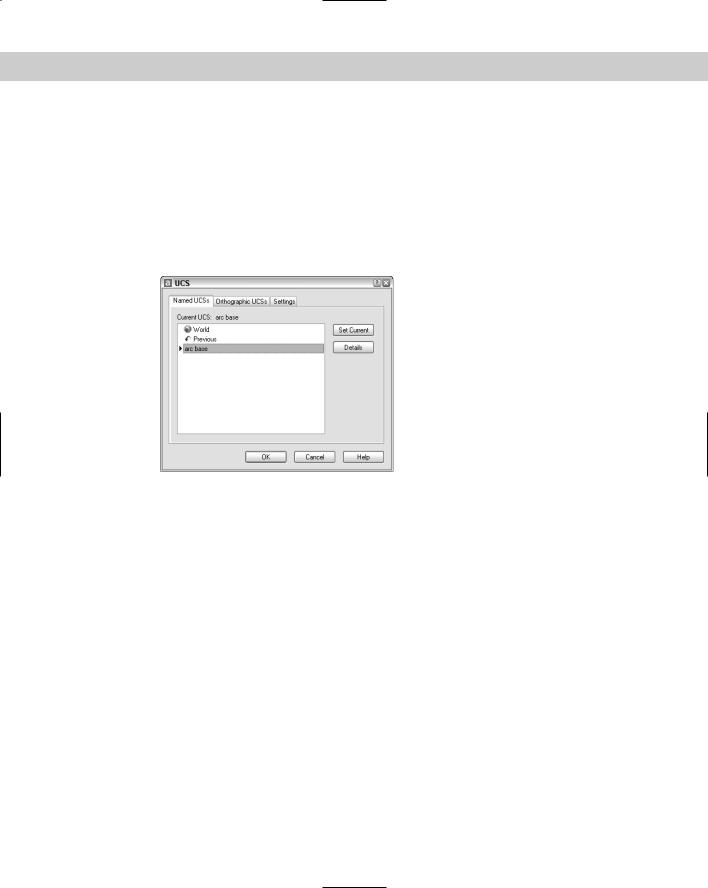
Chapter 8 Viewing Your Drawing 147
Saving and restoring a custom UCS
After you create a UCS, you can save it so that you can easily switch back and forth between the World Coordinate System and your UCS. To save a UCS, follow these steps:
1.Specify the UCS as described in the previous section.
2.Choose Tools Named UCS to open the UCS dialog box with the Named UCSs tab on top, as shown in Figure 8-20. If your current UCS is not named, it is listed as Unnamed and highlighted. Previously named UCSs are also listed. You can also use this dialog box to return to the previous UCS or the World Coordinate System (WCS).
Figure 8-20: Use the UCS dialog box to save and restore a UCS.
3.Click Unnamed. Type a name for the UCS and press Enter. The name can be up to 255 characters and can include spaces.
4.Click OK.
To restore a saved UCS, choose Tools Named UCS. Choose the UCS that you want to use and click Set Current. Then click OK. You can use the same dialog box to return to the previous UCS you used. You can also choose UCS Previous from the UCS toolbar. Using this button, you can quickly switch back and forth between two UCSs. To delete a saved UCS, select it in the UCS dialog box and press the Del key. You can also select a UCS, right-click, and choose one of the options from the shortcut menu.
Controlling the UCS icon
When you start a new drawing, the UCS icon is at the bottom-left of your drawing at 0,0. By default, the icon remains at 0,0 even if you pan around the drawing. The icon may, therefore, end up in the middle of your drawing. If 0,0 is not displayed, then the icon reverts to the bottom-left of your drawing.
You can turn off the UCS icon completely. If you aren’t working with customized UCSs, you often have no reason to see the UCS in a 2D drawing. If you want the UCS icon on, you can also display it only at the bottom-left of your drawing — to keep the icon out of the way so that it does not obstruct your drawing.

148 Part II Drawing in Two Dimensions
If you create a new UCS, keeping the UCS icon at the 0,0 point (the origin) of your new UCS helps you get your bearings. A plus sign appears in the icon to indicate the origin. However, if the origin is out of the current display or so close to the edge that the icon won’t fit, the UCS icon appears at the lower-left corner of your drawing anyway.
To control the UCS icon, choose View Display UCS Icon. (Don’t confuse this with Tools New UCS, which creates a custom UCS.) A submenu opens with the following items:
On: Toggles the display of the UCS icon on and off.
Origin: Toggles the placement of the UCS icon at the origin on and off.
You can customize the look of the UCS icon. To customize the look of the UCS icon, choose View Display UCS Icon Properties to open the UCS Icon dialog box, shown in Figure 8-21. As you make changes, you can see the result in the preview box.
Figure 8-21: Use the UCS Icon dialog box to customize the look of the UCS icon.
Choose between 2D and 3D styles. The 3D style shows the Z axis, but you won’t see it when you’re looking at your model from the top (called Plan view). If you choose the 3D style, you can check the Cone box to display a cone effect for the arrows of the X and Y axes. Either way, the Z axis has no arrow, so that you can distinguish it from the X and Y axes. You can also choose a line width from 1 to 3, 1 being the default.
You can change the size of the icon. Just drag the slider up and down to get the result you like. Finally, you can change the color of the icon both in model space and in paper space layouts. Click OK to close the dialog box.
Using a custom UCS
Although it seems confusing at first, after you try creating your own UCS it’s easier to understand how the process works.
In this exercise, you practice drawing with a custom UCS to create the basic framework for the drawing shown previously in Figures 8-17 and 8-18, a bearing housing for a commercial dryer.
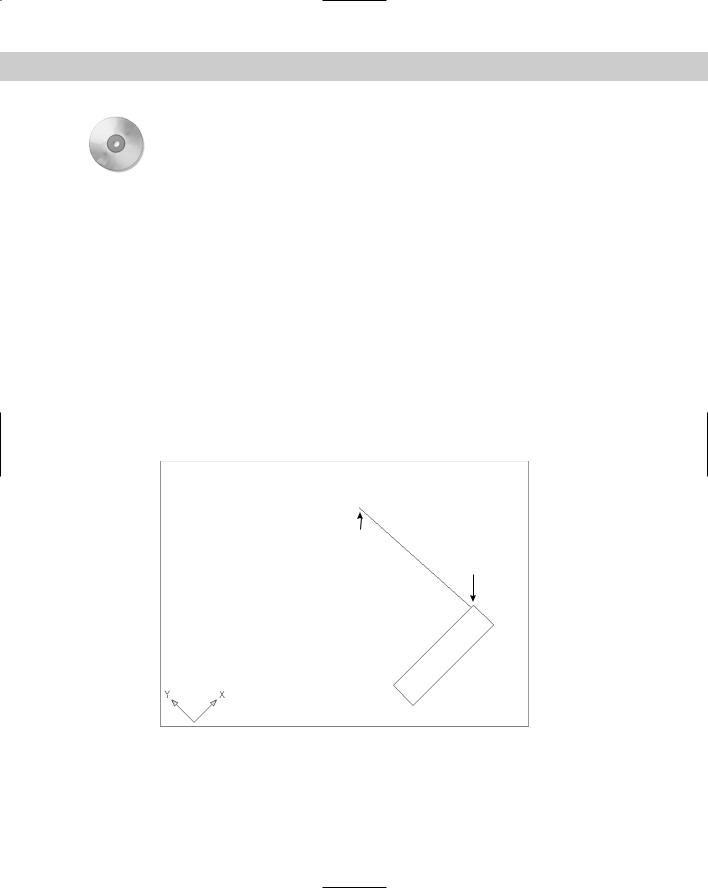
Chapter 8 Viewing Your Drawing 149
On the |
The drawing used in the following Step-by-Step exercise on drawing with a custom UCS, |
CD-ROM |
ab08-d.dwg, is in the Drawings folder on the CD-ROM. |
STEP-BY-STEP: Drawing with a Custom UCS
1.Open ab08-d.dwg from the CD-ROM.
2.Save the file as ab08-03.dwg in your AutoCAD Bible folder. ORTHO should be on. If necessary, turn on OSNAP. Set a running object snap for endpoints only.
3.Choose Tools New UCS Z. Because no objects exist in the drawing, you cannot easily use the 3 Point or Object options that might otherwise be useful.
4.At the Specify rotation angle about Z axis <90>: prompt, type 45 . The UCS icon and crosshairs are displayed at a 45-degree angle.
5.Choose Rectangle from the Draw toolbar. At the prompt, pick a point at the bottom
center of your screen. At the Specify other corner point or [Dimensions]: prompt, type @3-15/16,31/32 . The command creates the rectangle at the proper angle.
6.Start the LINE command. At the Specify first point: prompt, choose the From
object snap. At the Base point: prompt, use the Endpoint object snap to pick point 1 in Figure 8-22. At the <Offset>: prompt, type @-1/8,0 . At the Specify next point or [Undo]: prompt, type @5-3/16<93.3 . End the LINE command.
2
1
Figure 8-22: Starting to draw the framework for the bearing housing drawn by using a customized UCS.
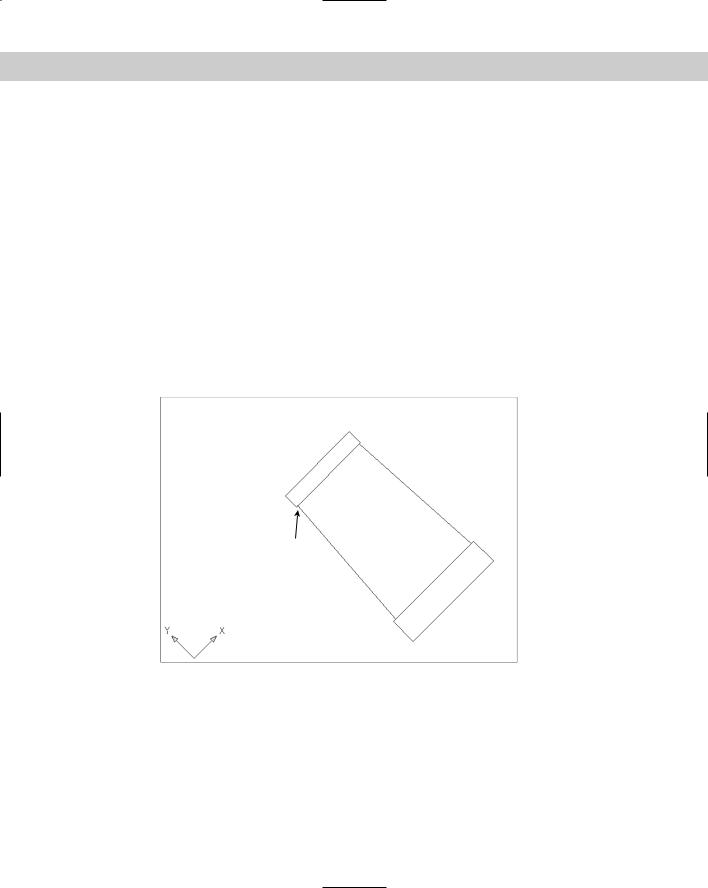
150 Part II Drawing in Two Dimensions
7.Start the LINE command again. Follow the prompts:
Specify first point: Choose the From object snap.
Base point: Use the Endpoint object snap to pick point 2 in Figure
8-22.
<Offset>: @1/16,0
Specify next point or [Undo]: Move the cursor in the 90° direction relative to the UCS. 35/64 . (Remember that the UCS has been rotated 45 degrees so that 90 degrees looks like 135 degrees.)
Press F6 twice for polar coordinates (if necessary) to confirm the 90° direction as you move the cursor.
Specify next point or [Undo]: Move the cursor in the 180° direction.
3-9/64
Specify next point or [Close/Undo]: Move the cursor in the 270° direction. 35/64
Specify next point or [Close/Undo]: c (to close the figure)
8.Start the LINE command. At the Specify first point: prompt, choose the From
object snap. At the Base point: prompt, use the endpoint object snap to pick 1 in Figure 8-23. At the <Offset>: prompt, type @1/16,0 .
1
2
Figure 8-23: The completed framework for the bearing housing.
9.At the Specify next point or [Undo]: prompt, again choose From. At the
Base point: prompt, use the endpoint object snap to pick 2. At the <Offset>: prompt, type @1/8,0 to complete the model, as shown in Figure 8-23. End the LINE command.
10.Because you would normally continue working on this drawing, you should save the UCS. Choose Tools Named UCS. In the UCS dialog box, click Unnamed. Type Rotated 45 and press Enter.
